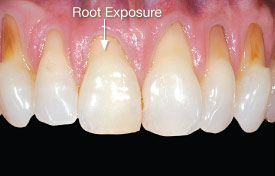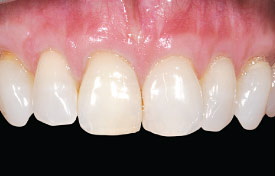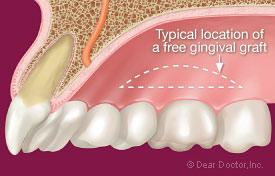Periodontal Plastic Surgery
Treating Gum Recession With Gingival (Gum Tissue) Grafting
(Continued)
Diagnosis and Assessment
As with any medical problem, a thorough assessment and diagnosis of the situation is critical to making the right treatment choices and ensuring a successful outcome. In the case of gum recession, this involves a detailed examination of all the teeth, especially their position within their supporting bone, and the surrounding gum tissues. For example, poor tooth position may require orthodontics to realign and improve biting function and to allow for more predictable surgical repair.
It is also fundamentally important to make sure individuals with gum recession correct faulty hygiene habits prior to treatment so that they will not jeopardize the future result.
 |
| Gum recession can continue to progress if the cause of the problem is not corrected. |
 |
|
| Today's periodontal plastic procedures can correct gum recession, by replacing lost tissue with allografts and also improving the smile. | |
| Photos provided by Dr. Edward Allen | |
 |
| This is the area of the palate where a thin layer of gum tissue is removed for free gingival grafts. Complete healing always occurs. |
Plastic Periodontal Surgery
The term “plastic” is derived from the Greek word “plastic,” which denotes sculpting or the art of modeling. Plastic surgery is a medical sub-specialty devoted to the correction or restoration of form and function. Though cosmetic or aesthetic surgery is the best-known kind of plastic surgery, it includes reconstructive surgery and microsurgery, both of which are elements in periodontal plastic surgery (peri – around; odont – tooth).
A periodontal specialist/periodontist typically performs these procedures, or a general dentist who has taken advanced training in plastic periodontal surgical techniques. Much of the success of periodontal plastic surgery relates to the periodontal surgeon's know-how, i.e., knowledge of anatomy and experience of which techniques to use and when to use them.
Gingival (Gum) Tissue Grafting
The periodontal structures, which include the gum tissues, are among the most widely researched in the body; as a result, the specialty of periodontics has developed predictable surgical techniques to deal with recession. The field of plastic periodontal surgery has made enormous strides in the last 20 years. It includes creating or regenerating lost or damaged gingival (gum) tissues.
Grafting techniques have been devised both to create and augment zones of attached gingival (gum) tissue where none exists, and to cover exposed root surfaces. Grafting is the surgical manipulation of tissue, taking it from one site, the donor, and moving it to another, the recipient, where it will attach and grow. There are two basic gingival grafting techniques, the so-called free gingival graft, and the connective tissue graft.

